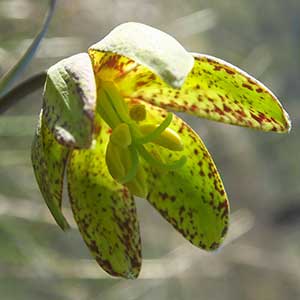Fritillaria glauca
Fritillaria liliacea
Siskiyou fritillaria, Siskiyou fritillary, Siskiyou missionbells
fragrant fritillary
large 3–9; small 1–9.
large 2–7; small 1–2.
0.8–2 dm.
1–3.5 dm.
2–4, alternate, 3.5–9 cm;
blade lanceolate-oblong, sickle-shaped, glaucous.
2–20, alternate, 3.5–12 cm;
blade linear to ovate.
nodding;
tepals purplish or greenish marked with yellow, lanceolate-oblong, 1.5–2.5 cm, apex not recurved;
nectaries green with maroon dots, broadly lanceolate, less than 1/2 tepal length;
style obviously branched for 1/2 its length, branches longer than 1.5 mm.
nodding, odorless or faintly fragrant;
tepals white, striped green, 1–1.6 cm, apex not recurved;
nectaries obscure, purplish to greenish, narrowly linear, forming narrow band 1/2–2/3 tepal length;
style obviously branched for 1/2 its length, branches longer than 1.5 mm.
broadly winged.
obtusely angled.
= 24.
= 24.
Fritillaria glauca
Fritillaria liliacea
Of conservation concern.
Fritillaria liliacea is sometimes confused with F. agrestis, which has flowers with an unpleasant odor. This species is in cultivation, and is considered rare and endangered in California.
(Discussion copyrighted by Flora of North America; reprinted with permission.)


